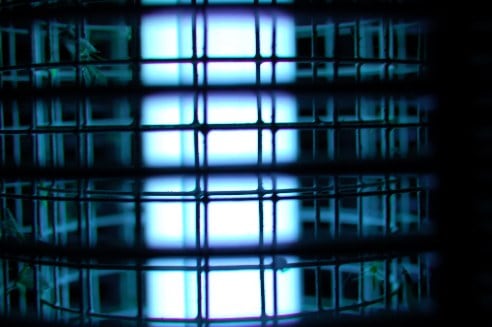- 5 Simple Tricks to Eliminate Maggots From Pet Waste - October 24, 2023
- Keep Your Outdoor Compost Piles Maggot-Free - October 24, 2023
- How to Get Rid of Maggots – Methods that Work - August 30, 2023
Did you know that under optimal conditions (25°C = 77 °F) fruit flies live for about 50 days from their inception? During this period, the female fruit fly can lay close to 400 eggs into alcohol-laden food sources like fruits or they can lay them in decaying mushrooms and sap fluxes – laying about five eggs at a time. Both male and female fruit flies are polygamous, so they mate a lot too. On top of this, fruit flies are known to spread and transmit diseases to humans; they are what we call disease vectors.
Fruit flies are also not exactly pleasant to be in the presence of. It then makes sense to want to get rid of them. This article is a guide of how one can eliminate this infestation, mainly through the use of a bug zapper. A bug zapper is a device that emits varying wavelengths of light to attract bugs and insects to an electric mesh-grid that will then electrocute them to death by heating their bodies to extreme temperatures.
Why are bugs attracted to bug zappers?
The use of light to control bug behaviour extends far beyond household pest control. The underlying rationale seems to be that some bugs and insects will not fly to what they cannot see. This rationale is extended to reason that they will then fly to what they can see. This, however, does not mean that some insects will not intentionally fly away from what they can see. Insects which move towards or away from a light source are called phototaxic insects. These two behaviours are respectively used to trap insects or repel them away usually from cultivation areas. Fruit flies are capable of seeing ultraviolet light (UV), unlike humans.
They are particularly attracted to UVA light, as opposed to UVB and UVC. This is most probably because UVA is the most abundant ultraviolet light source on Earth from the sun, and UVB and UVC are extremely harmful to live organisms, including fruit flies. UVB light is what causes sunburn.
Bug zappers are then, therefore, a light source that is meant to attract bugs and electrocute them when they’re close enough. Bug zappers often emit a combination of ultraviolet light and visible light to attract a wide variety of bugs, not just fruit flies. This is since other bugs see and are attracted to other wavelengths of light. Ultraviolet light also doesn’t exclusively attract fruit flies.
What bugs are attracted to bug zappers?
A bug zapper is mainly used to trap and violently destroy flying insects that are likely to spread diseases either by biting humans or coming into contact with them or their food. Some of these insects are flies, gnats and to a very small degree, mosquitos. Though mosquitos are attracted to light, they are more attracted to the Carbon Dioxide humans breath out and if the bug zapper doesn’t consider this in its design, it may not prove to be as effective in killing mosquitoes. Some bug zappers today, however, come with Octenol (AKA mushroom alcohol) which is contained in human breath and sweat. It is then effective in attracting mosquitoes to the electric mesh-grid of the zapper. Apart from attracting these “harmful” bugs, bug zappers are also known to attract other non-harmful insects like fireflies and beetles. This is why some may call them the indiscriminate brute-force killers.
Do bug zappers work on flies?
A bug zapper emits ultraviolet light which fruit flies and house flies are attracted to. It tends to successfully kill them. But it is important to use it properly. First of all, make sure you lure the flies away from your home by placing the bug zapper at the furthest possible place away from your house (usually more than 100 feet on the outside area of your home or building). This also prevents the bugs from spreading harmful bacteria and viruses when they explode from the electrocution. Make sure to not use the bug zapper near food or near places where you’d prepare food like barbeque grills. This approach probably means that you will then need multiple bug zappers around the house to account for bugs coming in from different directions to best mitigate their presence.
It is also important to note that a lot of bug zappers use fluorescent light which works by electrically exciting Mercury; a well-known neurotoxin. Therefore, one should be careful in disposing of it. There are, however, bug zappers which make use of LED lighting instead, which is relatively quite safe. One article proposes the use of a technique called pulse-width modulation of LED lighting. Which means that the LED light is not constantly kept on, but is flashed rapidly enough to make it seem like it is always on. This further reduces electricity consumption considering how efficient LEDs already are. It then makes it easier to develop battery-powered bug zappers which last long.
Given the need to use multiple bug zappers, and the fact that they are indiscriminate brute-force killers, where some scatter mist containing disease-infested bug insides, it may be preferable to consider other ways of getting rid of fruit fly infestations. There are other alternatives, like fly traps that make use of apple cider vinegar or beer. Alternatively one can also use fly swatters, insecticide Aerosols, or you can grow plants which flies hate like lavender, mint, lemongrass, and basil. We explore some of these methods from here.

Do electric fly swatters work on fruit flies?
Yes. Electric fly swatters will kill fruit flies. Electric fly swatters work in the same way as bug zappers, except they don’t necessarily have a UV light source to attract the bugs. Instead, you have to go play squash with bug balls. This may be an amusement for some and may feel quite rewarding. When the surface of the fly swatter comes into contact with a fly, it electrocutes it which leads to instant death by explosion. You can use this device pretty much anywhere, except near places where you don’t want the insides of a bug splattered all over – like your food, dining table, or barbeque grill. When choosing the best fly swatter, consider the following
- It should produce more than 3000 Volts for it to be of any good.
- It should have a rechargeable battery for convenience.
- A built-in flashlight will help for outdoor uses like camping applications and it also allows the swatter to work similarly to a bug zapper by attracting other insects which may be bothersome.
The use of a fly swatter requires some level of skill or effort to track and hit the fly in motion. It may thus not be the fastest way to get rid of flies even if one is skilled because flies aren’t always in the air and they may be hiding in places that are hard to access with a swatter. So one would then have to wait to kill them. This way wastes some time. No fret though, there are other ways to quickly kill flying insects.
What is the fastest way to get rid of fruit flies?
The answer to this depends on what is meant by “get rid”. If you find yourself in the literal presence of many flies all at once, then some of your options (from fastest to slowest) are:
- Making use of a multi-insect spray from your local grocer. Odourless ones are usually preferable. These can get rid of insects, including household flies and fruit flies.
- Make or buy flypaper, Flypaper has a strong scent and is sticky. It will attract flies and keep trap them indefinitely.
- Use fly repellent spray. This can be bought or made from essential oils like lavender, clove, mint, lemongrass, and basil. Add a solution of either of these to water and just constantly keep spraying around your house.
Otherwise, for long-term solutions, methods that require the least amount seem to be:
- Buying plants that naturally repel flies away from your home like mint, lavender, and basil.
- Reduce accessible food sources for the flies and clean up after pets.
- Build fly traps:
- One such is the paper cone and ripe fruit trap. Here you will need a container like a drinking glass, ripe fruit preferably with a strong scent, and a piece of paper. Fold the piece of paper into a cone-line shape and place the narrow end inside the glass which contains the ripe fruit. This will our the flies in and trap them inside.
- A similar trap can be constructed with apple cider vinegar. Here, you will need a plastic with a small hole through, and a drinking glass with the apple cider vinegar poured inside. Place the plastic over the glass and sit and wait while the flies flock towards it and get trapped inside.
There are many other fly traps one could use like pouring vinegar and dish soap into a tray and leaving it open to trap flies since they will stick because of the altered surface tension.
In using fly traps, remember to always be careful when disposing of the little bounty caught as it may carry diseases. Happy hunting.
Sources:
https://news.liverpool.ac.uk/tag/fruit-fly/
https://www.nytimes.com/2017/11/13/science/flies-biology.html
Related posts:
How to get rid of fruit flies
